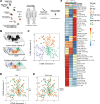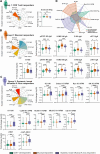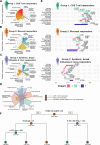This is a preprint.
Integrative Mapping of Pre-existing Immune Landscapes for Vaccine Response Prediction
- PMID: 39896552
- PMCID: PMC11785181
- DOI: 10.1101/2025.01.22.634302
Integrative Mapping of Pre-existing Immune Landscapes for Vaccine Response Prediction
Update in
-
Integrative mapping of pre-existing influenza immune landscapes predicts vaccine response.J Clin Invest. 2025 Jul 15:e189300. doi: 10.1172/JCI189300. Online ahead of print. J Clin Invest. 2025. PMID: 40663396
Abstract
Predicting individual vaccine responses remains a significant challenge due to the complexity and variability of immune processes. To address this gap, we developed immunaut, an open-source, data-driven framework implemented as an R package specifically designed for all systems vaccinologists seeking to analyze and predict immunological outcomes across diverse vaccination settings. Leveraging one of the most comprehensive live attenuated influenza vaccine (LAIV) datasets to date - 244 Gambian children enrolled in a phase 4 immunogenicity study - immunaut integrates humoral, mucosal, cellular, transcriptomic, and microbiological parameters collected before and after vaccination, providing an unprecedentedly holistic view of LAIV-induced immunity. Through advanced dimensionality reduction, clustering, and predictive modeling, immunaut identifies distinct immunophenotypic responder profiles and their underlying baseline determinants. In this study, immunaut delineated three immunophenotypes: (1) CD8 T-cell responders, marked by strong baseline mucosal immunity and extensive prior influenza virus exposure that boosts memory CD8 T-cell responses, without generating influenza virus-specific antibody responses; (2) Mucosal responders, characterized by pre-existing systemic influenza A virus immunity (specifically to H3N2) and stable epithelial integrity, leading to potent mucosal IgA expansions and subsequent seroconversion to influenza B virus; and (3) Systemic, broad influenza A virus responders, who start with relatively naive immunity and leverage greater initial viral replication to drive broad systemic antibody responses against multiple influenza A virus variants beyond those included in the LAIV vaccine. By integrating pathway-level analysis, model-derived contribution scores, and hierarchical decision rules, immunaut elucidates how distinct immunological landscapes shape each response trajectory and how key baseline features, including pre-existing immunity, mucosal preparedness, and cellular support, dictate vaccine outcomes. Collectively, these findings emphasize the power of integrative, predictive frameworks to advance precision vaccinology, and highlight immunaut as a versatile, community-available resource for optimizing immunization strategies across diverse populations and vaccine platforms.
Conflict of interest statement
Competing interests: Authors declare that they have no competing interests. Florian Krammer (FK) declares the following conflicts of interest. The Icahn School of Medicine at Mount Sinai has filed patent applications regarding influenza virus vaccines on which FK is listed as inventor. The Icahn School of Medicine at Mount Sinai has filed patent applications relating to SARS-CoV-2 serological assays, NDV-based SARS-CoV-2 vaccines, influenza virus vaccines, and influenza virus therapeutics, which list FK as co-inventor, and FK has received royalty payments from some of these patents. Mount Sinai has spun out a company, Kantaro, to market serological tests for SARS-CoV-2 and another company, Castlevax, to develop SARS-CoV-2 vaccines. FK is a co-founder and scientific advisory board member of Castlevax. FK has consulted for Merck, GSK, Sanofi, Curevac, Seqirus, and Pfizer and is currently consulting for 3rd Rock Ventures, Gritstone, and Avimex. The Krammer laboratory is also collaborating with Dynavax on influenza vaccine development and with VIR on influenza virus therapeutics.
Figures





Similar articles
-
Integrative mapping of pre-existing influenza immune landscapes predicts vaccine response.J Clin Invest. 2025 Jul 15:e189300. doi: 10.1172/JCI189300. Online ahead of print. J Clin Invest. 2025. PMID: 40663396
-
Interactions between live attenuated influenza vaccine and nasopharyngeal microbiota among children aged 24-59 months in The Gambia: a phase 4, open-label, randomised controlled trial.Lancet Microbe. 2025 Mar;6(3):100971. doi: 10.1016/j.lanmic.2024.100971. Epub 2025 Jan 17. Lancet Microbe. 2025. PMID: 39832517 Clinical Trial.
-
Systemic Inflammatory Response Syndrome.2025 Jun 20. In: StatPearls [Internet]. Treasure Island (FL): StatPearls Publishing; 2025 Jan–. 2025 Jun 20. In: StatPearls [Internet]. Treasure Island (FL): StatPearls Publishing; 2025 Jan–. PMID: 31613449 Free Books & Documents.
-
Vaccines for preventing influenza in healthy children.Cochrane Database Syst Rev. 2018 Feb 1;2(2):CD004879. doi: 10.1002/14651858.CD004879.pub5. Cochrane Database Syst Rev. 2018. PMID: 29388195 Free PMC article.
-
Immunogenicity and seroefficacy of pneumococcal conjugate vaccines: a systematic review and network meta-analysis.Health Technol Assess. 2024 Jul;28(34):1-109. doi: 10.3310/YWHA3079. Health Technol Assess. 2024. PMID: 39046101 Free PMC article.
References
Publication types
Grants and funding
LinkOut - more resources
Full Text Sources
Research Materials
Miscellaneous
